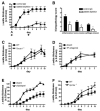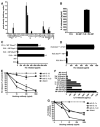Platelets amplify inflammation in arthritis via collagen-dependent microparticle production
- PMID: 20110505
- PMCID: PMC2927861
- DOI: 10.1126/science.1181928
Platelets amplify inflammation in arthritis via collagen-dependent microparticle production
Abstract
In addition to their pivotal role in thrombosis and wound repair, platelets participate in inflammatory responses. We investigated the role of platelets in the autoimmune disease rheumatoid arthritis. We identified platelet microparticles--submicrometer vesicles elaborated by activated platelets--in joint fluid from patients with rheumatoid arthritis and other forms of inflammatory arthritis, but not in joint fluid from patients with osteoarthritis. Platelet microparticles were proinflammatory, eliciting cytokine responses from synovial fibroblasts via interleukin-1. Consistent with these findings, depletion of platelets attenuated murine inflammatory arthritis. Using both pharmacologic and genetic approaches, we identified the collagen receptor glycoprotein VI as a key trigger for platelet microparticle generation in arthritis pathophysiology. Thus, these findings demonstrate a previously unappreciated role for platelets and their activation-induced microparticles in inflammatory joint diseases.
Figures




Comment in
-
Immunology. Arsonists in rheumatoid arthritis.Science. 2010 Jan 29;327(5965):528-9. doi: 10.1126/science.1185869. Science. 2010. PMID: 20110488 Free PMC article.
References
-
- Gartner LP, Hiatt JL, Strum JM. BRS Cell Biology and Histology. 5. Lippincott Williams & Wilkins; Philadelphia, PA: 2006.
-
- George JN. Lancet. 2000;355:1531. - PubMed
-
- Davì G, Patrono C. N Engl J Med. 2007;357:2482. - PubMed
-
- Helmick CG, et al. Arthritis Rheum. 2008;58:15. - PubMed
-
- Lee DM, Weinblatt ME. Lancet. 2001;358:903. - PubMed
Publication types
MeSH terms
Substances
Grants and funding
LinkOut - more resources
Full Text Sources
Other Literature Sources

